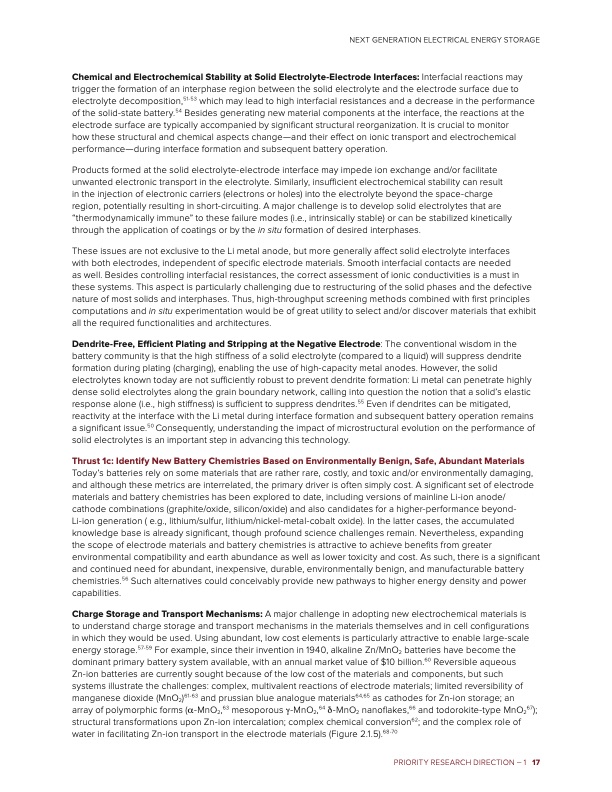
PDF Publication Title:
Text from PDF Page: 023
Chemical and Electrochemical Stability at Solid Electrolyte-Electrode Interfaces: Interfacial reactions may trigger the formation of an interphase region between the solid electrolyte and the electrode surface due to electrolyte decomposition,51-53 which may lead to high interfacial resistances and a decrease in the performance of the solid-state battery.54 Besides generating new material components at the interface, the reactions at the electrode surface are typically accompanied by significant structural reorganization. It is crucial to monitor how these structural and chemical aspects change—and their effect on ionic transport and electrochemical performance—during interface formation and subsequent battery operation. Products formed at the solid electrolyte-electrode interface may impede ion exchange and/or facilitate unwanted electronic transport in the electrolyte. Similarly, insufficient electrochemical stability can result in the injection of electronic carriers (electrons or holes) into the electrolyte beyond the space-charge region, potentially resulting in short-circuiting. A major challenge is to develop solid electrolytes that are “thermodynamically immune” to these failure modes (i.e., intrinsically stable) or can be stabilized kinetically through the application of coatings or by the in situ formation of desired interphases. These issues are not exclusive to the Li metal anode, but more generally affect solid electrolyte interfaces with both electrodes, independent of specific electrode materials. Smooth interfacial contacts are needed as well. Besides controlling interfacial resistances, the correct assessment of ionic conductivities is a must in these systems. This aspect is particularly challenging due to restructuring of the solid phases and the defective nature of most solids and interphases. Thus, high-throughput screening methods combined with first principles computations and in situ experimentation would be of great utility to select and/or discover materials that exhibit all the required functionalities and architectures. Dendrite-Free, Efficient Plating and Stripping at the Negative Electrode: The conventional wisdom in the battery community is that the high stiffness of a solid electrolyte (compared to a liquid) will suppress dendrite formation during plating (charging), enabling the use of high-capacity metal anodes. However, the solid electrolytes known today are not sufficiently robust to prevent dendrite formation: Li metal can penetrate highly dense solid electrolytes along the grain boundary network, calling into question the notion that a solid’s elastic response alone (i.e., high stiffness) is sufficient to suppress dendrites.55 Even if dendrites can be mitigated, reactivity at the interface with the Li metal during interface formation and subsequent battery operation remains a significant issue.50 Consequently, understanding the impact of microstructural evolution on the performance of solid electrolytes is an important step in advancing this technology. Thrust 1c: Identify New Battery Chemistries Based on Environmentally Benign, Safe, Abundant Materials Today’s batteries rely on some materials that are rather rare, costly, and toxic and/or environmentally damaging, and although these metrics are interrelated, the primary driver is often simply cost. A significant set of electrode materials and battery chemistries has been explored to date, including versions of mainline Li-ion anode/ cathode combinations (graphite/oxide, silicon/oxide) and also candidates for a higher-performance beyond- Li-ion generation ( e.g., lithium/sulfur, lithium/nickel-metal-cobalt oxide). In the latter cases, the accumulated knowledge base is already significant, though profound science challenges remain. Nevertheless, expanding the scope of electrode materials and battery chemistries is attractive to achieve benefits from greater environmental compatibility and earth abundance as well as lower toxicity and cost. As such, there is a significant and continued need for abundant, inexpensive, durable, environmentally benign, and manufacturable battery chemistries.56 Such alternatives could conceivably provide new pathways to higher energy density and power capabilities. Charge Storage and Transport Mechanisms: A major challenge in adopting new electrochemical materials is to understand charge storage and transport mechanisms in the materials themselves and in cell configurations in which they would be used. Using abundant, low cost elements is particularly attractive to enable large-scale energy storage.57-59 For example, since their invention in 1940, alkaline Zn/MnO2 batteries have become the dominant primary battery system available, with an annual market value of $10 billion.60 Reversible aqueous Zn-ion batteries are currently sought because of the low cost of the materials and components, but such systems illustrate the challenges: complex, multivalent reactions of electrode materials; limited reversibility of manganese dioxide (MnO2)61-63 and prussian blue analogue materials64,65 as cathodes for Zn-ion storage; an array of polymorphic forms (a-MnO2,63 mesoporous γ-MnO2,64 δ-MnO2 nanoflakes,66 and todorokite-type MnO267); structural transformations upon Zn-ion intercalation; complex chemical conversion62; and the complex role of water in facilitating Zn-ion transport in the electrode materials (Figure 2.1.5).68-70 NEXT GENERATION ELECTRICAL ENERGY STORAGE PRIORITY RESEARCH DIRECTION – 1 17PDF Image | Next Generation Electrical Energy Storage

PDF Search Title:
Next Generation Electrical Energy StorageOriginal File Name Searched:
BRN-NGEES_rpt-low-res.pdfDIY PDF Search: Google It | Yahoo | Bing
Sulfur Deposition on Carbon Nanofibers using Supercritical CO2 Sulfur Deposition on Carbon Nanofibers using Supercritical CO2. Gamma sulfur also known as mother of pearl sulfur and nacreous sulfur... More Info
CO2 Organic Rankine Cycle Experimenter Platform The supercritical CO2 phase change system is both a heat pump and organic rankine cycle which can be used for those purposes and as a supercritical extractor for advanced subcritical and supercritical extraction technology. Uses include producing nanoparticles, precious metal CO2 extraction, lithium battery recycling, and other applications... More Info
| CONTACT TEL: 608-238-6001 Email: greg@infinityturbine.com | RSS | AMP |